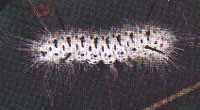
Identification
These attractive white and black caterpillars are covered in grayish-white hairs. There is a row of black tufts on the first eight abdominal segments and pairs of long black hair-tufts on the first and seventh segments.
Hosts
The caterpillars feed on the leaves of several hardwoods, but hickories, walnut and butternut are preferred. A related species occurs on sycamore.
Biology
Adults deposit eggs in May-June. Gregarious larvae feed for about eight weeks beginning in July. Winter is spent as pupae in gray, hair-covered cocoons under litter in the soil. There is one generation per year.
Control
Although this species may become locally abundant, it rarely causes severe defoliation, and control is usually not necessary.